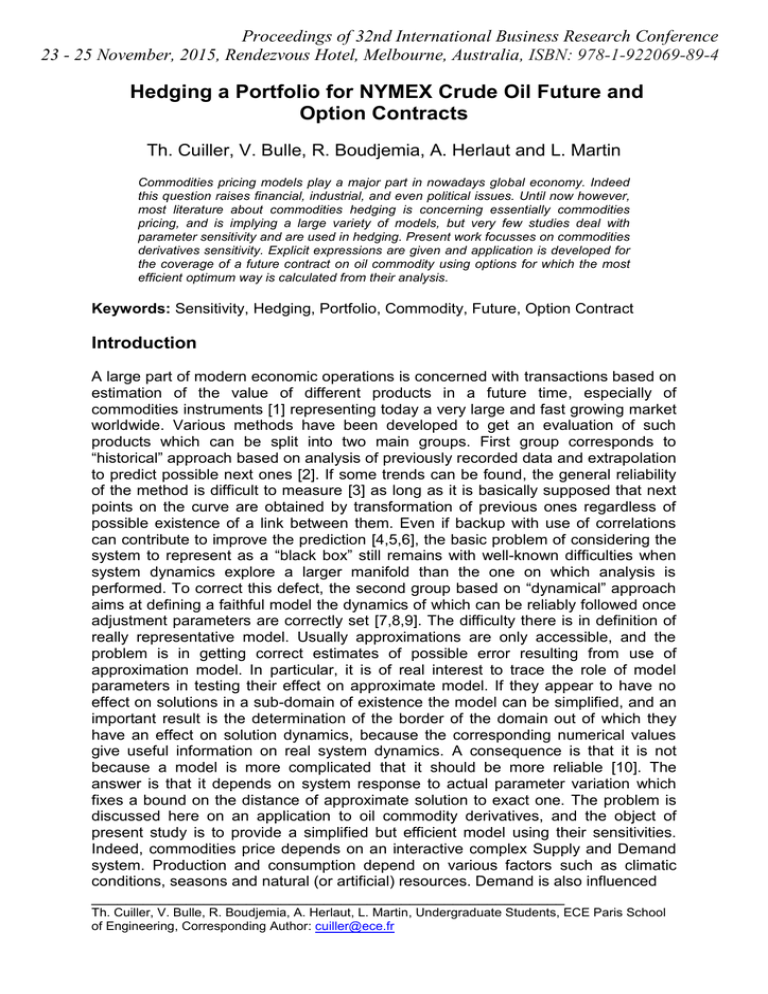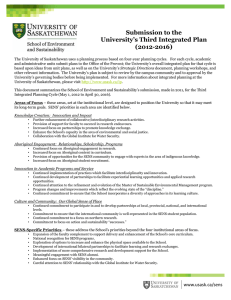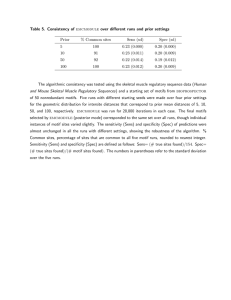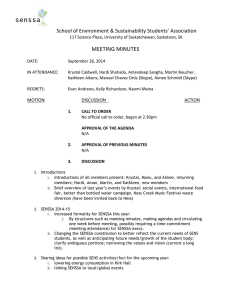Proceedings of 32nd International Business Research Conference
advertisement

Proceedings of 32nd International Business Research Conference
23 - 25 November, 2015, Rendezvous Hotel, Melbourne, Australia, ISBN: 978-1-922069-89-4
Hedging a Portfolio for NYMEX Crude Oil Future and
Option Contracts
Th. Cuiller, V. Bulle, R. Boudjemia, A. Herlaut and L. Martin
Commodities pricing models play a major part in nowadays global economy. Indeed
this question raises financial, industrial, and even political issues. Until now however,
most literature about commodities hedging is concerning essentially commodities
pricing, and is implying a large variety of models, but very few studies deal with
parameter sensitivity and are used in hedging. Present work focusses on commodities
derivatives sensitivity. Explicit expressions are given and application is developed for
the coverage of a future contract on oil commodity using options for which the most
efficient optimum way is calculated from their analysis.
Keywords: Sensitivity, Hedging, Portfolio, Commodity, Future, Option Contract
Introduction
A large part of modern economic operations is concerned with transactions based on
estimation of the value of different products in a future time, especially of
commodities instruments [1] representing today a very large and fast growing market
worldwide. Various methods have been developed to get an evaluation of such
products which can be split into two main groups. First group corresponds to
“historical” approach based on analysis of previously recorded data and extrapolation
to predict possible next ones [2]. If some trends can be found, the general reliability
of the method is difficult to measure [3] as long as it is basically supposed that next
points on the curve are obtained by transformation of previous ones regardless of
possible existence of a link between them. Even if backup with use of correlations
can contribute to improve the prediction [4,5,6], the basic problem of considering the
system to represent as a “black box” still remains with well-known difficulties when
system dynamics explore a larger manifold than the one on which analysis is
performed. To correct this defect, the second group based on “dynamical” approach
aims at defining a faithful model the dynamics of which can be reliably followed once
adjustment parameters are correctly set [7,8,9]. The difficulty there is in definition of
really representative model. Usually approximations are only accessible, and the
problem is in getting correct estimates of possible error resulting from use of
approximation model. In particular, it is of real interest to trace the role of model
parameters in testing their effect on approximate model. If they appear to have no
effect on solutions in a sub-domain of existence the model can be simplified, and an
important result is the determination of the border of the domain out of which they
have an effect on solution dynamics, because the corresponding numerical values
give useful information on real system dynamics. A consequence is that it is not
because a model is more complicated that it should be more reliable [10]. The
answer is that it depends on system response to actual parameter variation which
fixes a bound on the distance of approximate solution to exact one. The problem is
discussed here on an application to oil commodity derivatives, and the object of
present study is to provide a simplified but efficient model using their sensitivities.
Indeed, commodities price depends on an interactive complex Supply and Demand
system. Production and consumption depend on various factors such as climatic
conditions, seasons and natural (or artificial) resources. Demand is also influenced
_______________________________________________________
Th. Cuiller, V. Bulle, R. Boudjemia, A. Herlaut, L. Martin, Undergraduate Students, ECE Paris School
of Engineering, Corresponding Author: cuiller@ece.fr
Proceedings of 32nd International Business Research Conference
23 - 25 November, 2015, Rendezvous Hotel, Melbourne, Australia, ISBN: 978-1-922069-89-4
by interaction between economic or political factors and consumption habits. These
variations have a very serious impact on industries hedging strategy, and are the
causes of political and economic issues. For example, the 2014 sudden fall of crude
oil price impacted oil companies, and was at the origin of major troubles in several
countries with oil depending economies such as Russia, Iran, and Algeria. More
specifically, in energy markets high volatility and chronic specialness make the risk of
any outstanding spread position considerably greater than in typical other asset
classes, and demand for better future valuation is consequently more important [11].
To proceed, spot price information of a commodity is often so uncertain that it is
preferred to use the futures contract closest to maturity as a proxy for the spot price,
and Kalman filter [12] is used as a (recursive) procedure for computing the optimal
estimator of some unobserved state variables based on observations of related
futures prices. They are assumed to be measured with some noise, taking into
account bid-ask spreads, price limits, non-simultaneity and errors of data [7]. To limit
the uncertainty spread resulting from previous different effects, the model developed
here will be set to allow minimize risks on future contracts, by determining the parts
of call option needed in a portfolio to cover the futures, and protect the position from
any variation of asset price.
I- Commodity Derivatives Sensitivity Model
As many investigations and available hedging illustrations are essentially focused on
forward/future contracts, it seems also useful to consider contract options when
facing commodity market expansion. The financial literature is now rich in various
commodity models allowing to get closed pricing formulae both for future contracts
and related options [13]. Furthermore, as sensitivities for an option on commodity
future contract are allowing more flexibility than standard Greek parameters usually
given in terms of underlying future contract, they are built here in the line of a
portfolio risk management. The development is made in the framework of SchwartzSmith short term/long term (ST/LT) model for commodities [14], as it is a
parsimonious and well recognized one often preferred for empirical studies since it
provides econometric advantageous as the factors are more orthogonal [15]. The
approach presented here may be extended to the (industrial) shifted ST/LT model
mentioned above and also to other alternative models. One should remind that future
contracts are important both for practical and theoretical point of view. Indeed, they
are commonly used as hedging instruments whenever the position to hedge is a
linear combination of future/forward contracts. The work is based on the notion of
sensitivities functions introduced in order to approximate the price of a future or an
option contract, which help calculating futures or options through a linear easily
understandable expression. For simplicity, models with more than two factors [16] will
not be taken here, so with ST/LT model, there are some realizations ε1 ≡ εt,1 and ε2 ≡
εt,2 of independent standard Gaussian random variables such that price change
during the time period (0,t) of any future contract F(t,T) with maturity T is given to
second order by
F(t,T)(.) F(0,T) = Sens_Fut0 + Sens_Fut(1,0)*1(.) + Sens_Fut(0,1)*2(.) +
.5{Sens_Fut(2,0)*12(.) + Sens_Fut(1,1)*1(.)2(.) + Sens_Fut(0,2)*22(.)}
(1)
where j (j=1,2)are independent random Gaussian variables representing shocks and Sens_Fut(k,Nk)(.)
is Nth-sensitivity of future. At the same time, there are some realizations ε1 ≡ εt,1 and ε2 ≡ εt,2 such that
price change during time period (0,t) of an European option contract Opt(.), expiring at time T0 on a
future contract with maturity Tf , is given by
Proceedings of 32nd International Business Research Conference
23 - 25 November, 2015, Rendezvous Hotel, Melbourne, Australia, ISBN: 978-1-922069-89-4
Opt(.) OptSens_Opt00 + (Sens_Opt10) 1(.) + (Sens_Opt01)*2(.) +
.5{(Sens_Opt20)*12(.) + (Sens_Opt11)*1(.)2(.) + (Sens_Opt02)*22(.)}
(2)
Equations 1,2 are used for expressing the sensitivities of a commodity future/option change prices.
They are suitable here for hedging purpose in a portfolio framework. Explicit functions
Sens_Fut(k,Nk)(.) and Sens_Opt(k,Nk)(.) are collected in Appendix.
II – Hedging of Future by Options
Model is applied to portfolio hedging for crude oil futures and option contracts [17,18]. The choice of
oil commodity is based on the very large amount of financial instruments concentrated on it and on the
rather large fluctuations of its value due to the convergence of very different and important events.
The model is programed in R language and calculates derivatives sensitivity for an option on
commodity future contract. From existing literature the following parameter set is determined, see
Table I.
Table I. List and Value of Main System Parameters
To describe portfolio behavior, the new function Pr2 is introduced
Pr2(t) = Sens_Fut0(t) .Sens_Opt00(t) + Sens_Fut10(t).Sens_Opt10(t).E12
+ Sens_Fut01(t) .Sens_Opt01(t).E22 + Sens_Fut11(t).Sens_Opt11(t).E12E22/4
+ Sens_Fut20(t).Sens_Opt20(t).E14/4 + Sens_Fut02(t).Sens_Opt02(t).E24/4
(3)
This function represents the difference between a future price Fut(.), and option Opt1(.) weighted by a
coefficient , which is in fact the proportion of options covering a single future contract. The rest of
the study deals with minimizing Pr2 in order to limit eventual losses on the future contract by finding
best option coverage. This function is transferred on Microsoft Excel for minimization, and a solver is
used to output the value of necessary to optimize the future cover. Results with intermediate terms
are displayed on Table II (is termed “lambda” in third column).
Table II. Values of Main Functions in (1,2)
Proceedings of 32nd International Business Research Conference
23 - 25 November, 2015, Rendezvous Hotel, Melbourne, Australia, ISBN: 978-1-922069-89-4
From numerical figures in Table II, it can be checked that sensitivity coefficients are converging very
fast (Nth-order terms are smaller than (N 1)-ones, N ≤ 2, by at least two orders of magnitude), so
that second order is already sufficient for present calculation. For fixed normalized shock amplitudes
shown in columns 1 and 2, lowest (calculated) value of is displayed in third column. It can be
checked that variation of is only a few per cent even with variation of shock amplitudes by a factor
of 5, indicating a strong robustness of present calculation against a large dispersion of applied shocks.
A large dispersion of resulting price can also be observed in last column of lower Table, which gives
further support to proposed sensitivity approach for coverage optimization. To read the result, with for
instance two normalized shock amplitudes equal to 3 (first and second columns and first line of upper
Table) one gets in third column first line the value min = 0,4625268. So from this analysis, one
should sell approximatively 46 calls to buy 100 futures for highest protection.
Conclusion
Finding precise future evaluation of traded products is an important issue in modern economy,
especially for commodities like oil representing very large currency fluxes across countries manifested
by contracts with different issuing future time. Many instruments have been developed to approximate
“best” prices for these option contracts, and bounding error has been used in hedging methods.
However, in contrast to forward or swap contracts, the price of an option on future contract is a nonlinear expression of future price. This leads to a technical difficulty especially when the natural future
contract underlying the option is a non-tradable asset, and thus cannot be used for hedging purpose.
Then Greek parameters related to the option on the contract are not suitable, and sensitivities are to be
used instead. In present case, they are analytically derived for hedging a portfolio commodity future
and option contracts. A new cost function, representing the difference between future price Fut(.), and
option Opt1(.) weighted by a coefficient which is the proportion of options covering a single future
contract, is introduced. Minimization to limit losses on future contract is performed for a set of test
parameters corresponding to the example of crude oil commodity, and gives corresponding best option
coverage for portfolio hedging. Calculations can be extended to other types of future contracts.
Aknowledgements
The authors are very much indebted to ECE Paris School of Engineering for having provided the
environment where the study has been developed, to Dr Y. Rakotodatsimba for advices and guidance
during their work, and to Pr. M. Cotsaftis for help in preparing the manuscript.
References
[1] J. Back, M. Prokopczuk : Commodity Price Dynamics and Derivatives Valuation: a Review, Intern. J.
Theoretical and Applied Finance, Vol.16(6). ISSN 1793-632, 2013; G. Swindle : Valuation and Risk
Management in Energy Markets, Cambridge Univ. Press, Cambridge, Mass., 2014
[2] W. Brock, J. Lakonishok, B. Lebaron : Simple Technical Trading Rules and the Stochastic Properties of
Stock Returns, J. of Finance, Vol.47(5), pp.1731-1764, 1992
H. Mamaysky, Jiang Wang : Foundations of Technical Analysis: Computational Algorithms, Statistical
Inference, and Empirical Implementation, J. of Finance, Vol.55, pp.1705-1765, 2000; C.D. Kirkpatrick, J.R.
Dahlquist : Technical Analysis: The Complete Resource for Financial Market Technicians, Financial Times
Press, 2006; R.D. Edwards, J. Magee, W.H.C. Bassetti : Technical Analysis of Stock Trends, 9th Ed., American
Management Association, 2007
[3] C-H Park, S.H. Irwin : The Profitability of Technical Analysis: A Review, AgMAS Project Research, Report
N° 2004-04, 2004; and : What Do We Know About the Profitability of Technical Analysis? J. Economic
Surveys, Vol.21(4), pp.786-826, 2007
[4] G. Caginalp, H. Laurent : The Predictive Power of Price Patterns, Applied Math. Finance, Vol.5, pp.181-206,
1998
[5] P.V. Azzopardi : Behavioral Technical Analysis: An Introduction to Behavioral Finance and its Role in
Technical Analysis, Harriman House, 2010
[6] R.J. Van Eyden : The Application of Neural Networks in the Forecasting of Share Prices, Finance and
Technology Publishing, 1996; C. Klimasauskas : Applying Neural Networks, Neural Networks in Finance and
Investing, Ch.3, pp.47-72, Probus Publishing Company, 1993; K. Kamijo, T. Tanigawa : Stock Price Pattern
Recognition: A Recurrent Neural Network Approach, Neural Networks in Finance and Investing, Ch.21, pp.357370, Probus Publishing Company, 1993
Proceedings of 32nd International Business Research Conference
23 - 25 November, 2015, Rendezvous Hotel, Melbourne, Australia, ISBN: 978-1-922069-89-4
[7] E.S. Schwartz : The Stochastic Behavior of Commodity Prices: Implications for Valuation and Hedging, J.
Finance, Vol.52(3), pp.923-973, 1997
[8] C. Francq, J.M. Zakoïan : GARCH Models: Structure, Statistical Inference and Financial Applications. J.
Wiley and Sons, UK Ltd, 2010; M. Krayzler, R. Zagst, B. Brunner: Closed-form Solutions for Guaranteed
Minimum Accumulation Benefits, Working Paper, Technische Univ. München, Germany, 2012; E. Chiasson :
Valeur Exposée au Risque: Estimations par des Modèles de Corrélations Conditionnelles Dynamiques. Ph.D.
Thesis, Université du Québec à Montréal, July 2012
[9] B. Pesaran, H.M. Pesaran : Conditional Volatility and Correlations of Weekly Returns and the VaR Analysis
of 2008 Stock Market Crash, Economic Modelling.Vol.27, pp.1398-1416, 2010; also : Modelling Volatilities and
Conditional Correlations in Futures Markets with a Multivariate t-Distribution. CESIFO Working Paper n°2056,
Group 10, 2007; F. Black, M.S. Scholes : The Pricing of Options and Corporate Liabilities, J. Political
Economy, Vol.81(3), pp.637-654, 1973
[10] G. Caginalp, M. DeSantis : Nonlinearity in the Dynamics of Financial Markets, Nonlinear Analysis: Real
World Applications, Vol.12(2), pp.1140-1151, 2011; E. Benhamou, Z. Wang, A.G. Galli : Is Multi-factor Really
Necessary to Price European Options in Commodity? http://papers.ssrn.com/sol3/papers. cfm? Abstract _id =
1310624, 2009
[11] M. Eydeland, K. Wolyniec : Energy and Power Risk Management, New Developments in Modeling,
Pricing and Hedging, J. Wiley and Sons, New York, 2003; M. Burger, B. Graeber, G. Schindlmayr : Managing
Energy Risk, an Integrated View on Power and Other Energy Markets, J. Wiley and Sons, New York, 2007
[12] A.C. Harvey : Applications of the Kalman Filter in Econometrics, Advances in Econometrics, T.F. Bewley,
ed., Cambridge University Press, 1994
[13] G. Dempster E. Medova K. Tang : Long Term Spread Option Valuation and Hedging, J. Banking and
Finance, Vol.32, pp.2530-2540, 2008; O. Korn : Drift Matters: an Analysis of Commodity Derivatives, J.
Futures Markets, Vol.25(3), pp.211-241, 2005
[14] E. Schwartz, J. Smith : Short-term Variations and Long-term Dynamics in Commodity Prices, Management
Sciences, Vol.46(7), pp.893-911, 2000
[15] D. Brigo, K. Chourdakis, I. Bakkar : Counterparty Risk-Valuation for Energy Commodity Swaps, arXiv:
0901v1,q-fin.PR, 2009
[16] G. Cortazar, L.Naranjo : An n-Factor Gaussian Model of Oil Futures Prices, J. Futures Markets, Vol.26,
pp.243-268, 2006; Shiraya K. & Takahashi A. : Pricing and hedging a long-term futures and forward contracts
by a three-factor model, CARF Working Paper, CARF-F-113, 2009; X. Yan : Valuation of Commodity
Derivatives in a New Multi-Factor Model, Review of Derivatives Research, Vol.5, pp.251-271, 2002
[17] C. Campi, F. Goldenzi : Oil Markets and Products, in Handbook of Multi-commodity Markets and
Products, A.Roconroni, G. Fusai, M. Cummins, Eds., J. Wiley and Sons, 2015; G. Lautier, A.G. Galli :
Dynamic Hedging Strategies: an Application to the Crude Oil, http://papers.ssrn.com/ sol3/papers.cfm?abstract
_id=1568019, 2010
[18] R. Carmona, M. Ludkovski : Spot Convenience Yield Models for Energy Markets, AMS Mathematics of
Finance, G. Yin & Y. Zhang eds., Vol.351 of Contemporary Mathematics, pp. 6580, 2004; G. Cortazar, E.S.
Schwartz : Implementing a Stochastic Model for Oil Futures Prices, Energy Economics, Vol.25 pp.215-238,
2003; R. Gibson, E.S. Schwartz : Stochastic Convenience Yield and the Pricing of Oil Contingent Claims, J.
Finance, XLV(3), pp.959-976, 1990
Appendix
I. Auxiliary Functions
D±(t) = Vt(t)1{log(Ft(t)/K) ± .5Vt(t)2} ; O(t) = P(t){Ft(t)||D+(t)||p K||D(t)||p} (O(0)=.179)
x(t) = E(t,k)x0-F(t,k)x)+(x).F(t,2k)1/2.{sqrt(1w(t)2.E1+w(t).E2) }
y(t) = y0+[µ(y)y))t+(y)t1/2E2
P(t) = exp(r(T0 t)) ; F(a,b) = b1[1exp(ab)] ; E(a,b) = exp(ab)
O2(t) = P(t){exp(B(t,k)).exp(Ax(t,k)E1+Ay(t,k)E2)}||a+(t)+bx(t).E1+by(t).E2||p
K||a(t)+bx(t).E1+by(t).E2||p (O2(0)=3.76)
V(t) = {|x)2 E(Tf T0,2k).F(T0 t,2k)+((y)2(T0 t)+2p.x).y)E(Tf T0,k)F(T0 t,k)|}1/2
Conv(t) = .5F(Tf t,2k).x)2 + .5(y)2(Tf t) + pk1x).y) F(Tf t,k)
F(t) = exp{E(Tf,k) x(t) + y(t) F(Tf t,k).(x) + [µ(y) y)].(Tf t) + Conv(Tf t)}
F2(t) = exp[B(t,k)+Ax(t,k).E1+Ay(t,k).E2]
B0(a,b) = E(Tf,b).x(0) + y(0) F(Tf,b).(x) + [µ(y)y)].Tf + Conv(a)
B(a,b) = E(Tf,b).x(a) + y(a) F(Tf,b).(x) + [µ(y)y)].Tf + Conv(a)
a+(t) =V(t)1log(1/K) + .5V(t)2 + B(Tf,k) ; a(t) = V(t)1log(1/K) + .5V(t)2 + B0(Tf,k)
w(t) = pF(t,k)[|F(t,2k)|t]1/2
Proceedings of 32nd International Business Research Conference
23 - 25 November, 2015, Rendezvous Hotel, Melbourne, Australia, ISBN: 978-1-922069-89-4
Ax(a,b) = |1 w(a)2|1/2.x).|F(a,2b)|1/2.E(Tf a,b) ; bx(t) = V(t)1Ax(t,k)
Ay(a,b) = w(a).x).|F(a,2b)|1/2.E(Tf a,b) + (y).a1/2 ; by(t) = V(t)1Ay(t,k)
II. Functions Sens_Opt(k,Nk)(.) (N,k = 0,1,2)
Sens_Opt00(t) = E(T0 t,r).exp(B(t,k)).||a+(t)||p K.||a(t)||p Opt0
Sens_Opt10(t) = E(T0 t,r).Ax(t,k).exp(B(t,k).||a+(t)||p + bx(t).exp(B(t,k). ||a+(t)||d K.bx(t).||a(t)||d
Sens_Opt01(t) = E(T0 t,r).Ay(t,k).exp(B(t,k)).||a+(t)||p + by(t).exp(B(t,k).||a+(t)||d K.by(t).||a(t)||d
Sens_Opt11(t) = 2E(T0 t,r).Ax(t,k)Ay(t,k).exp(B(t,k).||a+(t)||p + Ax(t,k).by(t) + bx(t).[Ay(t,k)
a+(t).bx(t).by(t)].exp(B(t,k).||a+(t)||d + K a(t).bx(t).by(t).||a(t)||d
Sens_Opt20(t) = E(T0 t,r).Ax(t,k)2.exp(B(t,k).||a+(t)||p + bx(t).[2Ax(t,k)
a+(t)bx(t)].exp(B(t,k).||a(t)||d + K.a(t).bx(t)2.||a(t)||d
Sens_Opt02(t) = E(T0 t,r).Ay(t,k)2.exp(B(t,k).||a+(t)||p + by(t).[2Ay(t,k)
a+(t)by(t)].exp(B(t,k).||a+(t)||d + K.a(t).by(t)2.||a(t)||d
III. Functions Sens_Fut(k,Nk)(.) (N,k = 0,1,2)
Sens_Fut00(t) = exp(B0(t,k)) Fut0
Sens_Fut10(t) = exp(B0(t,k)).Ax(t,2k)
Sens_Fut01(t) = exp(B0(t,k)).Ay(t,2k)
Sens_Fut20(t) = exp(B0(t,k)). Ax(t,2k)2
Sens_Fut02(t) = exp(B0(t,k)).Ay(t,2k)2
Sens_Fut11(t) = exp(B0(t,k)).2 Ax(t,2k) Ay(t,2k)



